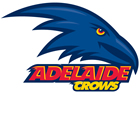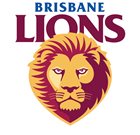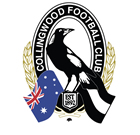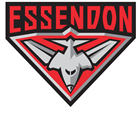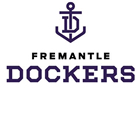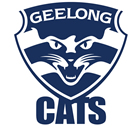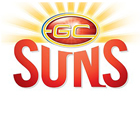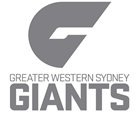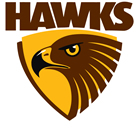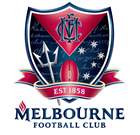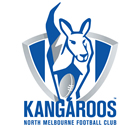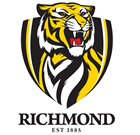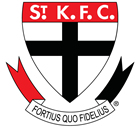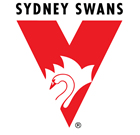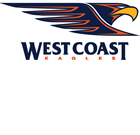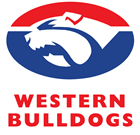Aussie Rules
A guide to Australia's gameReturn to Top
Return to Top
Return to Top
AFL Competition
Return to Top
AFL Field
AFL Match Duration
Players in an AFL Team
AFL Officials
Currently there are 3 central umpires, 4 boundary umpires and 2 goal umpires on-field for each AFL game.
Central umpires (or field umpires) move around the ground with the play, adjudicating the contest, awarding marks and free kicks for rule violations, balling-up to restart play after a stoppage, or executing a centre bounce to start play at the beginning of each quarter or after a goal is scored. They are the only umpire who can call time on or off.
Boundary umpires judge when the ball has left the field of play by crossing the boundary line in its entirety. They are responsible for the boundary line throw-in to restart play once the ball is out of bounds.
Goal umpires are responsible for adjudications relating to the goal line, goal posts and scoring. They judge if a shot for goal has crossed the line without being touched, and if the shot has gone between the goal (or behind) posts without hitting the post in order to register a score. Shots at goal that hit the goal post are considered behinds, and shots that hit the behind posts are considered out-of-bounds on the full. The goal umpires signal scores by hand and via flags (one for a behind, 2 for a goal) to ensure that all players, officials, and spectators can see what score registered.
In addition to these on-field umpires, there is a video replay adjudicator to assist the goal umpires with close scoring decisions, interchange stewards to monitor the number of players on-field at any one time, and an emergency umpire in case an umpire is injured and can’t continue. The emergency umpire is able to enter the field of play to assist breaking up fights or behind-the-play scuffles.
Return to Top
AFL Objectives
The objective is to score more total points that your opposition by propelling the ball between the goal posts (or behind posts) by foot. Score yourself, and stop the opposition form scoring – pretty much like every other team sport going around. You can move the ball by hand or foot around the ground to achieve this.
Return to Top
AFL Scoring
Scores are either a goal which equals 6 points, or a behind, which equals 1 point. Goals are scored by kicking the ball through the 2 goal posts at your scoring end. The ball must not be touched in any way by another player, and though it may touch the ground, it must not touch the post. If a ball goes through the goal posts, after touching any player on the ground, or is propelled through by hand rather than foot, a behind is awarded. If the ball hits the goal post, or goes between the goal post and behind post, then a behind is awarded. If the ball hits the behind post, then the ball is out-of-bounds, and is throw-in if it was touched or hit the ground first, or a free kick awarded to the defensive team if it hits the behind post on the full.
The score-line in an Aussie Rules games is written as Melbourne 7.5 (47) def Collingwood 3.9 (27). This means Melbourne scored 7 goals and 5 behinds for a total of 47 points and defeated Collingwood who scored 3 goals and 9 points for a total of 27 points. The score-line is read out loud as ‘Melbourne seven-five-forty-five defeated Collingwood three-nine-twenty-seven’.
Return to Top
AFL Plays
Kicking the ball is generally is done by dropping the ball onto your boot and swinging your foot through a downward arc to propel it, though drop-kicks or soccer-style kicks are also allowed. There are many types of kicks used throughout a game, depending on the length and accuracy required, angle of the kick in relation to goal and the wind direction. Popular options are the drop-punt, torpedo (aka barrel, spiral, screw-punt), banana/check-side, snap, dribble and the recently in vogue hook-kick.
Handballs (or handpasses) are a legal form of ball distribution using the hands. The ball is held in the palm of one hand and propelled by hitting it with the clenched fist of the other hand. Using an open palm to propel the ball is not an allowed form of handpass. Throwing, scooping or dropping the ball are not legal disposals. A ball may be tapped on, but the action must be a tap without taking possession, and cannot be a scoop where the ball is briefly palmed before being directed.
Marks are taken when a ball that has been kicked into the air, is caught on the full by a player. The ball may not touch the ground or another player from either team and must travel at least 15 metres in order to be paid as a mark. Once a mark is taken, the player with the ball may take a kick without threat of tackle or interference form the opposition. The position on the field that the catch was taken is referred to as ‘the mark’.
Full body tackles are allowed in Aussie Rules and you may tackle the opponent with the ball, between his shoulders and knees so long as he has possession of the ball. Tackles that go above the shoulders are penalised with a free-kick to the tackled player in order to protect the head, and tackles below the knees are considered trips, and a free-kick is likewise awarded. A push in the back is not considered a legal tackle and is also penalised with a free-kick.
Return to Top
Penalties in AFL
Free-kicks are awarded by Centre Umpires when a player contravenes a rule. These can be things such as incorrect disposal (ie. a throw), head-high tackle, a push in the back of a player with the ball, an illegal hold, a ball going out-of-bounds on the full from a kick, or even abusive language towards an umpire. Players must dispose of the ball quickly when tackled, or risk being ruled as holding the ball, or illegally disposing of the ball, and the tackler being rewarded with a free-kick. A call from the crowd of “BALL!” is common when spectators believe that the player with the ball has contravened the ‘holding the ball’ rule when tackled.
Many rules have significant grey-areas, and are open to the interpretation of the umpires, often leading to the ire of the players and the crowd.
If a player does not follow the instructions of the umpires, and ignores the free kick ruling, deliberately delays turning over the ball to hold up play, or verbally lashes out at the umpire, a 50 metres penalty can be awarded and the free-kick advanced 50 metres closer towards the goal of the player who was awarded the free kick.
Return to Top
AFL Supporters
Despite legions of passionate spectators and a full contact sport which often leads to on-field fracas, spectators are exceedingly well behaved. There is no division of supporters in the stadiums as is commonly seen in other sporting codes, and fights and disruptions rarely occur. In fact, the banter between supporters is usually well-meaning, and in my own experience, a very funny part of the entire experience.
Supporters may choose to become a member of their preferred club, purchasing memberships which entitle them to various packages, usually including entry and seating at games. Membership funds are a vital part of the clubs’ financial income each year, so keeping and increasing members is a large part of the clubs off-field operations. Of course, tickets may be purchased on an as-needed basis for non-members.
Return to Top
Current AFL Teams
Adelaide Football Club
Nickname: Crows
Home Ground: Adelaide Oval
Established: 1990
Team Colours: Blue, Red, Gold
Brisbane Lions
Nickname: Lions
Home Ground: The Gabba
Established: 1996*
Team Colours: Navy, Maroon, Gold
*after a merger of the existing Brisbane Bears (1986) and Fitzroy Lions (1883) clubs.
Carlton Football Club
Nickname: Blues
Home Ground: Docklands Stadium
Established: 1864
Team Colours: Navy, White
Collingwood Football Club
Nickname: Magpies
Home Ground: MCG
Established: 1892
Team Colours: Black, White
Essendon Football Club
Nickname: Bombers
Home Ground: Docklands Stadium
Established: 1871
Team Colours: Black, Red
Freemantle Football Club
Nickname: Dockers
Home Ground: Subiaco Oval
Established: 1994
Team Colours: Purple, White
Geelong Cats
Nickname: Cats
Home Ground: Karinda Park
Established: 1859
Team Colours: Navy Blue, White
Gold Coast Suns
Nickname: Suns
Home Ground: Carrara Stadium
Established: 2009
Team Colours: Red, Yellow, Blue
Greater Western Sydney (GWS) Giants
Nickname: Giants
Home Ground: Sydney Showground Stadium
Established: 2009
Team Colours: Orange, Grey
Hawthorn Football Club
Nickname: Hawks
Home Ground: MCG
Established: 1902
Team Colours: Yellow, Brown
Melbourne Football Club
Nickname: Demons
Home Ground: MCG
Established: 1858
Team Colours: Navy Blue, Red
North Melbourne
Nickname: Kangaroos
Home Ground: Docklands Stadium
Established: 1869
Team Colours: Royal Blue, White
Port Adelaide
Nickname: Power
Home Ground: Adelaide Oval
Established: 1870
Team Colours: Black, White, Teal.
Richmond Football Club
Nickname: Tigers
Home Ground: MCG
Established: 1885
Team Colours: Black, Yellow
St Kilda Football Club
Nickname: Saints
Home Ground: Docklands Stadium
Established: 1873
Team Colours: Red, White, Black
West Coast Eagles
Nickname: Eagles
Home Ground: Subiaco Oval
Established: 1986
Team Colours: Blue, Yellow, White.
Western Bulldogs
Nickname: Bulldogs
Home Ground: Docklands Stadium
Established: 1877
Team Colours: Red, White, Blue


